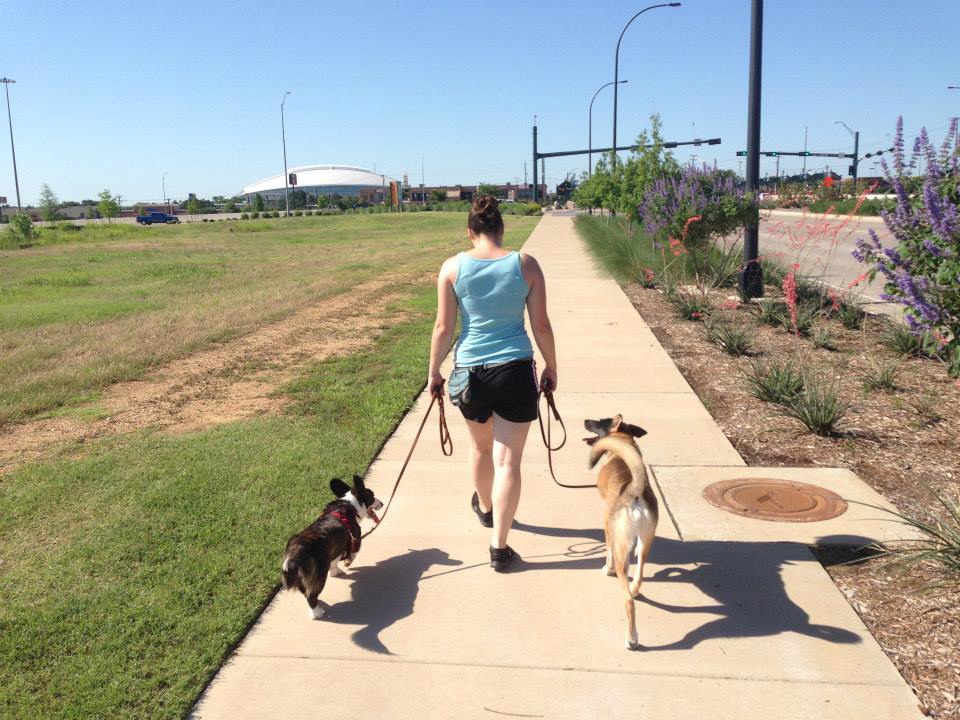Loose leash walking. *insert ominous music* Sometimes teaching loose leash walking to clients can feel like the bane of every dog trainer’s existence. It’s not that the skills needed are difficult. No, it’s the consistency and patience that are required that can make it so tedious. So, as a modern dog trainer, what are some ways you can help teach loose leash walking to your clients? Here, we’ll examine three videos that may be of benefit.
“Polite Walking On Leash” by Ines Gaschot
 This first video shows how starting simple can make such a big impact. Ines starts on the porch with her dog, Loker, simply clicking and treating for a loose leash while working in a small, relatively low distraction location. Ines illustrates how to increase difficulty via distractions and duration of behavior. She then does some troubleshooting for forging and offers alternative ways to reward dogs (changing up treat delivery, sniffing breaks, etc). She offers helpful tips at the beginning and end of the video. This video is fantastic due to its simplicity. It will be easy for your clients to grasp this concept and put it into play, even after you are gone.
This first video shows how starting simple can make such a big impact. Ines starts on the porch with her dog, Loker, simply clicking and treating for a loose leash while working in a small, relatively low distraction location. Ines illustrates how to increase difficulty via distractions and duration of behavior. She then does some troubleshooting for forging and offers alternative ways to reward dogs (changing up treat delivery, sniffing breaks, etc). She offers helpful tips at the beginning and end of the video. This video is fantastic due to its simplicity. It will be easy for your clients to grasp this concept and put it into play, even after you are gone.
“Clicker Training Loose Leash Walking” by Casey Lomonaco
Casey’s approach to loose leash walking is to emphasize the placement of treat delivery. Careful and consistent treat placement means the dog learns that being beside the owner is a Very Good Place to be. She starts slow, just standing in one place. She then begins pivoting 90 degrees each time to encourage the dog to start moving into position. After the dog is confidently doing that, she begins taking large single steps, changing direction frequently. To introduce longevity into the loose leash walking, Casey uses the “300 Peck” method. By the end of this short video, her puppy, Cuba, is politely offering loose leash walking even though he is off leash.
“How Do I Teach My Dog Not To Pull On Leash?” by Kevin Duggan
Kevin takes a different approach from the two videos above. His method is incredibly useful for dogs that aren’t as food motivated, or dogs that are in a highly distracting area. He teaches the dog that all forward movement stops if the leash gets tight. He then turns and goes another direction (“penalty yards”), teaching the dog that pulling towards a desired object actually makes it go further away. Kevin uses his voice as praise a great deal, some treats, and also a toy that his dog desires.
Conclusion
These videos all are highly simple and effective even though they use three different methods. Your clients will all have different learning styles, so being able to offer them several options for teaching this skill will ensure they have success.
What other methods do you like to use to teach your clients loose leash walking?
Get Dog Training Business Tips!
Receive valuable dog training business tips and resources every week! Subscribe to The Modern Dog Trainer now by submitting your name and email below.
[mc4wp_form]




